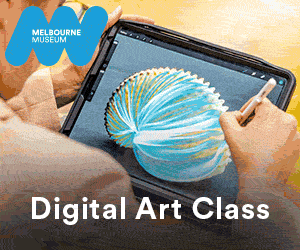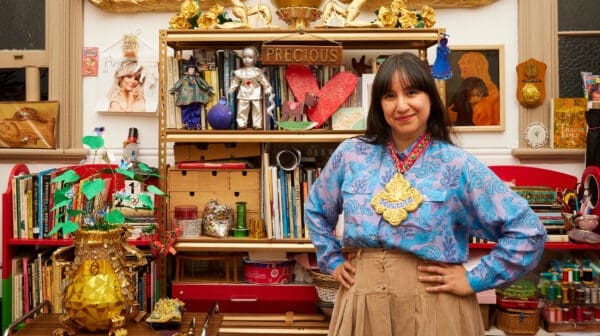I had arrived on the west coast in the manner of most east coast people imagining that life as it is lived at home would be the same for the friendly citizens of the most geographically isolated city on the planet. It’s a logical assumption to make – Perth looks like most other Australian capital cities; they have the same currency and their accents are virtually the same. There’s the time-zone difference of two hours [three in summer], which makes the visitor susceptible to a surprise case of jet lag, but the idea of having travelled into the past is so much fun that the momentary disorientation of waking up two hours early, or starting to seriously tire at 10pm, is just another enjoyable aspect of time travel.
Like Klaatu emerging from the flying saucer at the start of The Day the Earth Stood Still [the classic 1951 version, not the crap Keanu Reeves remake], I had a world shattering revelation: “PEOPLE OF PERTH… I COME WITH A MESSAGE FROM THE FUTURE – THE ART WORLD IS AWESOME AND EVERYTHING IS FINE…” But instead of a shocked reaction, people cowering in the majestic light of my words, there was nothing… Tumbleweeds.
What I didn’t know is that Perth is one possible future for the art world, not its past.
A couple of issues back I wrote about what the future of the commercial art gallery scene might look like, reasoning that whatever may come, the dealer-led model of a physical, bricks-and-mortar commercial gallery seems like the only rational way to do business. But how wrong could I be?
Well, very wrong, as it turns out. In 2004 I made my first visit to Perth and found an art scene riding high on the mining boom with multiple long-running commercial galleries, a brace of artist-run spaces, and the Fremantle Arts Centre, the Perth Institute of Contemporary Arts and the Art Gallery of Western Australia sitting atop the cake like three shiny glacé cherries.
In the years between, I heard about the decimation of Perth’s art scene as one commercial gallery after another closed its doors as the global financial crisis, the end of the mining boom and inevitable generational change took their toll. Still, when I glanced at the Perth listings in Art Guide and saw the names of what appeared to be more than a dozen galleries in addition to the much-loved cherries, it looked on paper to be an art scene still hanging on despite its depleted numbers. A couple of visits in the interim seemed to confirm that impression.
Then this year I was invited back to Perth by Turner Galleries to open Robert Hague’s show there in May. When I began chatting with people about what to see and where to go while I was in Perth, it became obvious that the options were severely limited. It turned out that a number of the galleries in listings were by-appointment only, occasional pop-ups or just tourist-style shop-fronts. Where I had once walked the streets of Perth and marvelled at the chutzpah of putting a corporate art collection in the foyer of a skyscraper, the streets now seemed cold and indifferent to art. FAC, PICA and the AGWA are still open for business and doing great work – indeed, the AGWA still seems like the personal plaything of curator Robert Cook, who manages to stage shows like Comic Tragics: The Exploding Language of Contemporary Comic Art, the sort of magnificently eccentric proposition that’d only get a run in a side gallery in an east coast museum.
Despite the seemingly never-ending proliferation of colourful public sculptures, Perth’s overall contraction is the logical outcome of a relatively small population that had been over-serviced by commercial galleries.
When the top end of town stopped buying, the commercial art scene began to shrink.
The university museums in Perth, such as the Lawrence Wilson Art Gallery and John Curtin Gallery, do good work, but the impression I had was that the situation for practising artists is bleak. The Moana Project Space, for example, a hire space for emerging artists, was little more than a few square metres at the back of a coffee shop sequestered on the first floor of a building that had once been a dance hall.
After my return to the future, I realised that this was perhaps the logical outcome of the capitalist system of commercial galleries, a Darwinian adapt-or-die model. There were interesting hints of another outcome, however: private galleries were acting as philanthropists by organising residences and collectors clubs.
This seemed like a good thing, a hybridisation of commercial and private approaches, and perhaps this is the future we’ll see elsewhere as major commercial galleries become private foundations and artist-run spaces are pushed out into the suburbs.
My last trip to Perth in July offered another glimmer of hope. Invited out to the artist-run space Success, I found a massive downstairs gallery in the basement of a former department store. The lights were blacked out for a video installation and lit rooms around the edges of the gallery floated like space stations in the darkness. The gallery is grand in scale but temporary – the building has been reclaimed as a Renew-style project that’ll run until the council kicks them out. There are coffee shops and clothing stores in there, too. But, in the meantime, the artists carry on as if there’s no tomorrow. Walking back up the non-functioning wooden escalators and into the light, I remembered a line from sci-fi author William Gibson – “The street finds a use for everything” – and thought, Well, this might be the end of the world but no one has told the artists.











